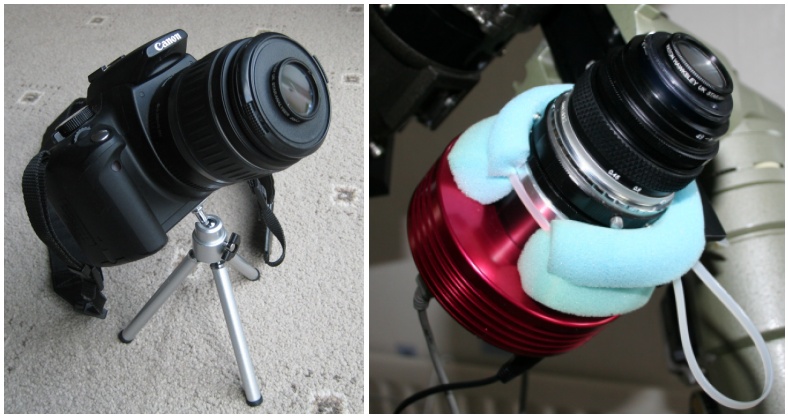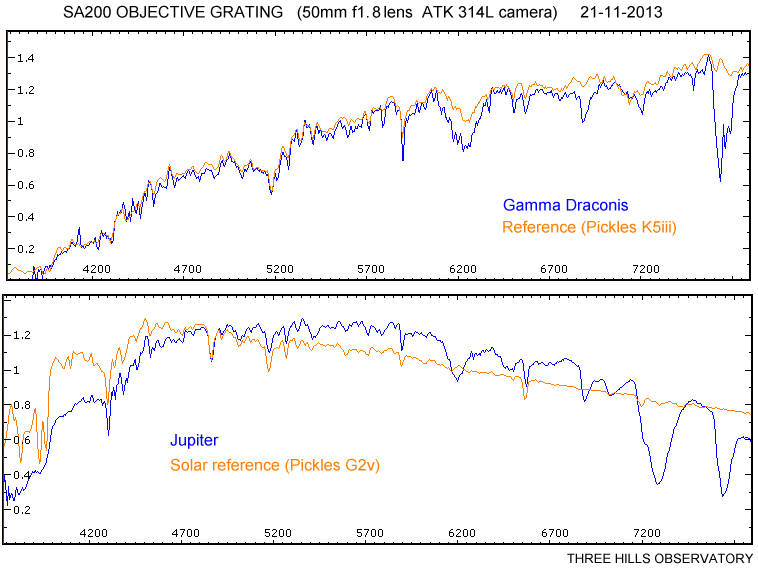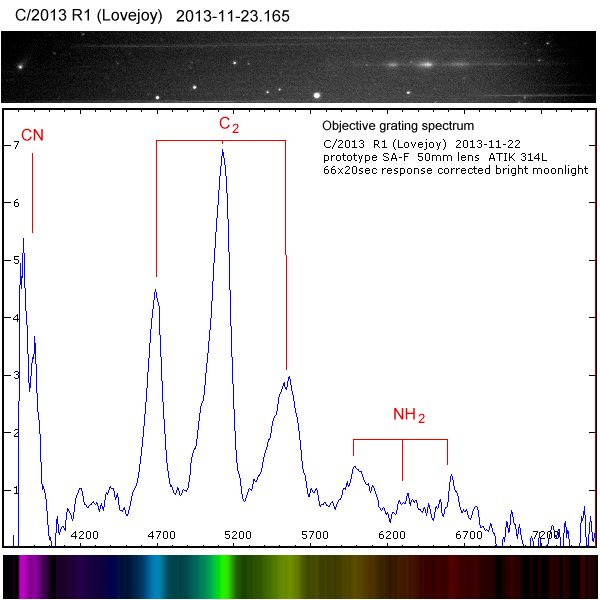The Star Analyser 200 used as an Objective Grating
mounted in front of a camera lens

Although the sensitivity is much lower of course due to the small aperture, this arrangement does have two significant advantages over the more usual configuration of the Star Analyser mounted in the converging beam between the telescope and camera sensor.
- Since the light beam is parallel though the grating, the
aberrations in the objective
grating
configuration
are
reduced
compared
with
the
usual
arrangement
of
mounting the
grating between
the
telescope and
camera
and therefore the
resolution
is
potentially
higher. See here for an example of the SA100
used
with a telephoto lens
and Digital
SLR
camera.
- Because the camera lens has a shorter focal length compared with a telescope, extended objects like comets, planets, planetary nebulae etc appear more point like. This allows spectra to be obtained of objects which could not otherwise be recorded successfully using the Star Analyser with a telescope. See here for example the spectrum of a comet recorded using a 100 l/mm grating (bottom of the page) using an early prototype of the SA100 mounted in front of a camera lens on a modified webcam
Using the SA200 instead of the SA100 in this configuration gives the same length of spectrum with a lens of half the focal length. This has some advantages:
1. When measuring extended objects where the resolution may be limited by the size of the object in the image.
2. The shorter focal length is more forgiving in terms of focus errors
3. There is less vignetting at the same aperture with the shorter focal length lens
(eg there is no vignetting with the Canon 350D and EF-S 18-55mm zoom at 55mm shown above)
4 . Depending on the quality of the lens, the resolution is potentially higher if the star image size is smaller with the shorter focal length.
5 . When using a fixed camera mount to produce a trailed spectrum, the trailed distance is shorter with the shorter focal length giving a brighter spectrum in the image.
6 . The SA200 can be used at 50mm focal length, within the range of the standard short focal length zooms typically supplied with DSLR
still giving the advantage of the higher resolution potential of the configuration but the SA100 needs a longer focal length telephoto lens
There are some disadvantages to consider however:
1. The wider field means there is greater risk of interfering background stars and spectra.
2. The sky background is brighter.
3. Star images are potentially undersampled and the resulting narrow spectrum increases the risk of artifacts due to insufficient coverage of rows of pixels,
particularly with colour cameras and where the spectrum is not exactly horizontal. Stacking frames or defocusing slightly can be used to reduce any
potential problems though and this is not a problem if you are using a fixed camera to produce a trailed spectrum.
Below are examples using the SA200 mounted in front of a 50mm f1.8 camera lens and an ATIK 314L+ cooled astro camera (shown top right of this page.)

Gamma Draconis (K5iii) and Jupiter
(Note the detailed features in the spectra which would be unresolved with the Star Analyser used conventionally in the converging beam between telescope and camera)

Comet R1 2012 Lovejoy
(Note how the comet appears almost stellar in the wide field image, producing a sharp spectrum)